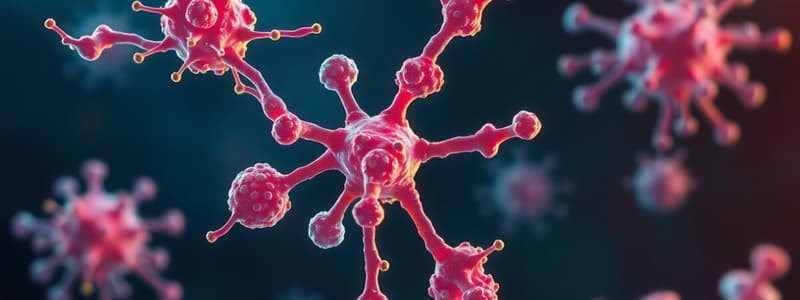Podcast
Questions and Answers
What characteristic enables Staphylococcus species to survive in a broad range of temperatures?
What characteristic enables Staphylococcus species to survive in a broad range of temperatures?
- They are halotolerant.
- They can grow at temperatures below 10 degrees Celsius.
- They are mesophiles. (correct)
- They are facultative anaerobes.
Which of the following traits of Staphylococcus makes it well-suited to living on human skin?
Which of the following traits of Staphylococcus makes it well-suited to living on human skin?
- It can tolerate high salt concentrations. (correct)
- It requires high oxygen levels for growth.
- It grows best in extreme temperatures.
- It thrives in high pH environments.
What is the potential consequence of Staphylococcus species accessing deeper tissues of the body?
What is the potential consequence of Staphylococcus species accessing deeper tissues of the body?
- They can enhance bacterial flora diversity.
- They can cause skin infections. (correct)
- They can improve skin health.
- They can lead to minor skin irritations.
What is a primary distinction of Staphylococcus aureus compared to other species in the Staphylococcus genus?
What is a primary distinction of Staphylococcus aureus compared to other species in the Staphylococcus genus?
Which of the following statements is true about Staphylococcus species?
Which of the following statements is true about Staphylococcus species?
Which of the following conditions could result from Staphylococcus species entering the bloodstream?
Which of the following conditions could result from Staphylococcus species entering the bloodstream?
How do Staphylococcus species affect skin health most of the time?
How do Staphylococcus species affect skin health most of the time?
Which species of Staphylococcus is recognized as particularly dangerous?
Which species of Staphylococcus is recognized as particularly dangerous?
What type of anaerobes are Staphylococcus species classified as?
What type of anaerobes are Staphylococcus species classified as?
Which environment is least favorable for Staphylococcus growth?
Which environment is least favorable for Staphylococcus growth?
What role do virulence factors play in the context of a pathogen's ability to cause disease?
What role do virulence factors play in the context of a pathogen's ability to cause disease?
Which of the following enzymes is produced specifically by Staphylococcus aureus?
Which of the following enzymes is produced specifically by Staphylococcus aureus?
How does Hyaluronidase contribute to the pathogenicity of S.aureus?
How does Hyaluronidase contribute to the pathogenicity of S.aureus?
Which type of toxin is produced exclusively by Gram-negative bacteria?
Which type of toxin is produced exclusively by Gram-negative bacteria?
What is a common characteristic of exotoxins?
What is a common characteristic of exotoxins?
Which virulence factor of S.aureus can cause gastrointestinal symptoms?
Which virulence factor of S.aureus can cause gastrointestinal symptoms?
What is the predominant effect of the Toxic Shock Syndrome toxin?
What is the predominant effect of the Toxic Shock Syndrome toxin?
Which property differentiates exotoxins from endotoxins?
Which property differentiates exotoxins from endotoxins?
What advantage does coagulase provide to Staphylococcus aureus?
What advantage does coagulase provide to Staphylococcus aureus?
Which of the following is NOT a type of toxin produced by Staphylococcus aureus?
Which of the following is NOT a type of toxin produced by Staphylococcus aureus?
Staphylococcus species are classified as Gram - bacilli.
Staphylococcus species are classified as Gram - bacilli.
S.aureus can survive in both high salt concentrations and acidic environments.
S.aureus can survive in both high salt concentrations and acidic environments.
Staphylococci grow fastest at very high temperatures above 46 degrees Celsius.
Staphylococci grow fastest at very high temperatures above 46 degrees Celsius.
Staphylococcus species are primarily harmful and do not contribute to skin health.
Staphylococcus species are primarily harmful and do not contribute to skin health.
S.epidermidis is known to be a dangerous species within the Staphylococcus genus.
S.epidermidis is known to be a dangerous species within the Staphylococcus genus.
Facultative anaerobes can survive only in the presence of oxygen.
Facultative anaerobes can survive only in the presence of oxygen.
Bacteremia occurs when bacteria are present in the bloodstream.
Bacteremia occurs when bacteria are present in the bloodstream.
The Staphylococcus genus is poorly adapted to the environment of human skin.
The Staphylococcus genus is poorly adapted to the environment of human skin.
Staphylococcus species can only cause infections when they are introduced into deeper tissues.
Staphylococcus species can only cause infections when they are introduced into deeper tissues.
S.saprophyticus is a benign species that cannot cause any infections.
S.saprophyticus is a benign species that cannot cause any infections.
Staphylococcus aureus produces both exotoxins and endotoxins as virulence factors.
Staphylococcus aureus produces both exotoxins and endotoxins as virulence factors.
Coagulase is an enzyme produced specifically by S.aureus that can be used to identify its presence.
Coagulase is an enzyme produced specifically by S.aureus that can be used to identify its presence.
Endotoxins are proteins released by living cells and are significant contributors to the pathogenicity of Gram-positive bacteria.
Endotoxins are proteins released by living cells and are significant contributors to the pathogenicity of Gram-positive bacteria.
Hyaluronidase allows S.aureus to spread through host tissues by breaking down hyaluronic acid.
Hyaluronidase allows S.aureus to spread through host tissues by breaking down hyaluronic acid.
Exotoxins have a lower potency compared to endotoxins.
Exotoxins have a lower potency compared to endotoxins.
Enterotoxins made by S.aureus can lead to gastrointestinal symptoms.
Enterotoxins made by S.aureus can lead to gastrointestinal symptoms.
Penicillinase produced by S.aureus provides the bacterium with resistance to the antibiotic penicillin.
Penicillinase produced by S.aureus provides the bacterium with resistance to the antibiotic penicillin.
Toxic Shock Syndrome toxin is classified as an exotoxin and can cause systemic effects.
Toxic Shock Syndrome toxin is classified as an exotoxin and can cause systemic effects.
All individual cells of S.aureus express the same virulence factors at all times.
All individual cells of S.aureus express the same virulence factors at all times.
Exotoxins can be produced by both Gram-positive and Gram-negative bacteria.
Exotoxins can be produced by both Gram-positive and Gram-negative bacteria.
Flashcards are hidden until you start studying
Study Notes
Staphylococcus Genus
- Staphylococcus genus contains several species that are normal flora on human skin and mucous membranes.
- Staphylococci are Gram-positive cocci in staphylo or irregular clusters.
- They are mesophiles, but can grow in a broad temperature range of 10 to 46 degrees Celsius.
- Staphylococci are facultative anaerobes and halotolerant.
- They are neutrophiles but acidotolerant.
- These traits make them uniquely adapted to the salty, acidic environment of human skin.
- Common staph flora of skin include S. saprophyticus, S. epidermidis, and S. aureus, which can cause infections if they gain access to deeper tissues.
Staphylococcus Aureus
- S. aureus is normal flora on human skin and mucous membranes.
- It can produce various virulence factors, making it more dangerous than other Staphylococcus species.
- Virulence factors are produced by pathogens to increase their pathogenicity and cause disease.
Staphylococcus Aureus Virulence Factors: Exoenzymes
- Coagulase: coagulates plasma, used to identify S. aureus.
- Hyaluronidase: also called "spreading factor," digests host tissues, allowing bacteria to spread.
- Staphylokinase: digests blood clots, allowing the infection to spread further.
- Penicillinase: degrades penicillin, providing antibiotic resistance.
Staphylococcus Aureus Virulence Factors: Toxins
- Toxins are poisonous chemical products made by one organism that are harmful to another organism.
- Exotoxins are proteins made and released by living cells.
- Endotoxins are only produced by Gram-negative bacteria and are released when the cells die and rupture.
- Enterotoxins: cause gastrointestinal symptoms.
- Exfoliative toxin: causes separation of the epidermis from the dermis.
- Toxic Shock Syndrome toxin: causes severe systemic effects.
- Hemolysin: lyses red blood cells.
Staphylococcus Genus
- The genus Staphylococcus contains several species that are normal flora on the skin and mucous membranes of humans and other mammals.
- Staphylococci are Gram-positive cocci that occur in clusters.
- Staphylococcus is hardy and can grow in diverse environments.
- Grows best at moderate temperatures (mesophiles).
- Can grow in a wide temperature range (10-46°C).
- Facultative anaerobes, meaning they can survive with or without oxygen.
- Haltolerant, meaning they can tolerate high salt concentrations.
- Neutrophiles, meaning they grow best at neutral pHs.
- Acidotolerant, meaning they can tolerate acidic environments.
- These traits make them uniquely adapted to the salty, acidic environment of human skin.
- Several species in this genus can cause skin infections, urinary tract infections, bacteremia, and septicemia.
- Common staph flora of the skin include S. saprophyticus, S. epidermidis, and S. aureus.
Staphylococcus aureus
- Staphylococcus aureus is a normal flora on human skin and mucous membranes.
- S. aureus produces a number of virulence factors that make it more dangerous than other Staphylococcus species.
- Virulence factors are produced by pathogens that increase pathogenicity and cause disease.
- S. aureus secretes various enzymes and toxins that act as virulence factors.
- Individual S. aureus cells may not have all virulence factors, and they may not produce all enzymes and toxins simultaneously.
S. aureus Exoenzymes
- Coagulase: coagulates plasma, used to identify S. aureus.
- Hyaluronidase: "spreading factor" that digests host tissues, allowing bacteria to spread.
- Staphylokinase: digests blood clots, allowing infection to spread.
- Penicillinase: degrades penicillin, leading to antibiotic resistance.
Toxins
- Toxins are poisonous substances produced by organisms.
- Exotoxins are proteins made by living cells that are released into their environment.
- Exotoxins are potent and have specific targets.
- Enterotoxins target the GI tract.
- Neurotoxins target the nervous system.
- Endotoxins are made only by Gram-negative bacteria.
- Endotoxins are released from Gram-negative cells as they die and rupture.
- Endotoxins are less potent than exotoxins but have more systemic targets.
- Endotoxin is a pyrogen, causing fever.
- S. aureus, being Gram-positive, produces exotoxins.
S. aureus Exotoxins
- Enterotoxins: cause gastrointestinal symptoms.
- Exfoliative toxin: causes separation of the epidermis from the dermis.
- Toxic Shock Syndrome toxin: causes severe systemic effects.
- Hemolysin: lyses red blood cells.
Studying That Suits You
Use AI to generate personalized quizzes and flashcards to suit your learning preferences.





